I Need to Find an Apartment
Long story short: I’ve taken a new position in Luxembourg and I have to find an apartment, in a different country, in a reasonably short time.
TL;DR: I hate apartment hunting, I’ve tried to make it as interesting as possible by creating a pipeline with different tools and languages to scrape data from a website with the use of Puppeteer, load data into a SQLite database using Go and visualizing all the data with Python and Folium.
If you want to look at the final code or follow along with me you can checkout the project repo on GitHub.
I initially sketched what I was looking for by priority
After that it was time for the boring stuff: looking for an apartment that best fits my requirements.
I have a couple of friends in Lux and they all told me to look on the infamous website AtHome.lu to get an idea on the available apartments that there are in Lux, so I did.
I don’t like doing this, so I try to make things easier by just looking at the pictures and if the price looks ok I’ll just bookmark the thing so that I can look at it later for comparisons.
This quickly becomes hard to do. Some agencies will publish part of the monthly price, some of them will post the actual monthly price. Each agency fee is different and it’s not immediately visible. The map on the website is just awful and it won’t let me compare positions with other apartments. Needless to say that it is pretty much impossible to choose the right one with this messy data.
What I’d like to have is a big map with all the apartments that I like on it and maybe a database to query apartments to show by different parameters.
Let’s see if we can scrape some data off of athome.lu!
After giving a quick look at the website I’ve found out that by selecting
the renting apartments in the Luxembourg area, links start with this URL path
www.athome.lu/en/rent/apartment/luxembourg, each apartment
has a unique id and the complete address for an apartment looks like this
www.athome.lu/en/rent/apartment/luxembourg/id-642398588.html.
This is a good start, it means that I can pretty much navigate to a specific apartment page just by knowing its id.
If I inspect the html source of a single page, I immediately notice that there is a HUGE json object with a lot of data in it at the bottom of the page,
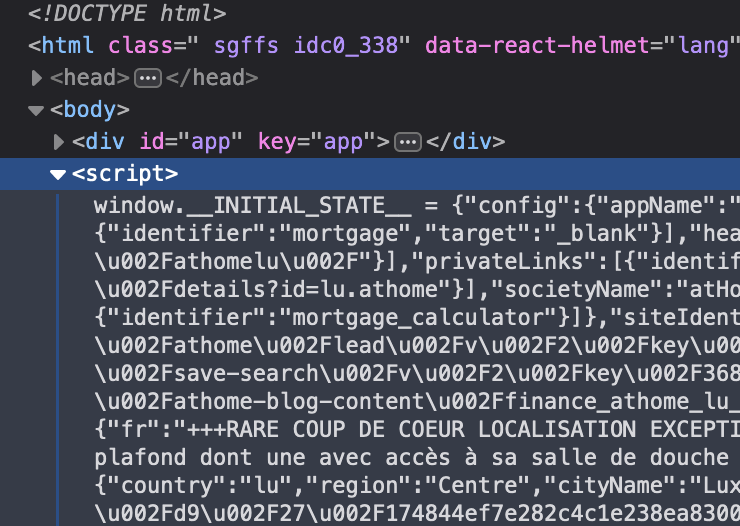
Let’s see if we can find something interesting in it.
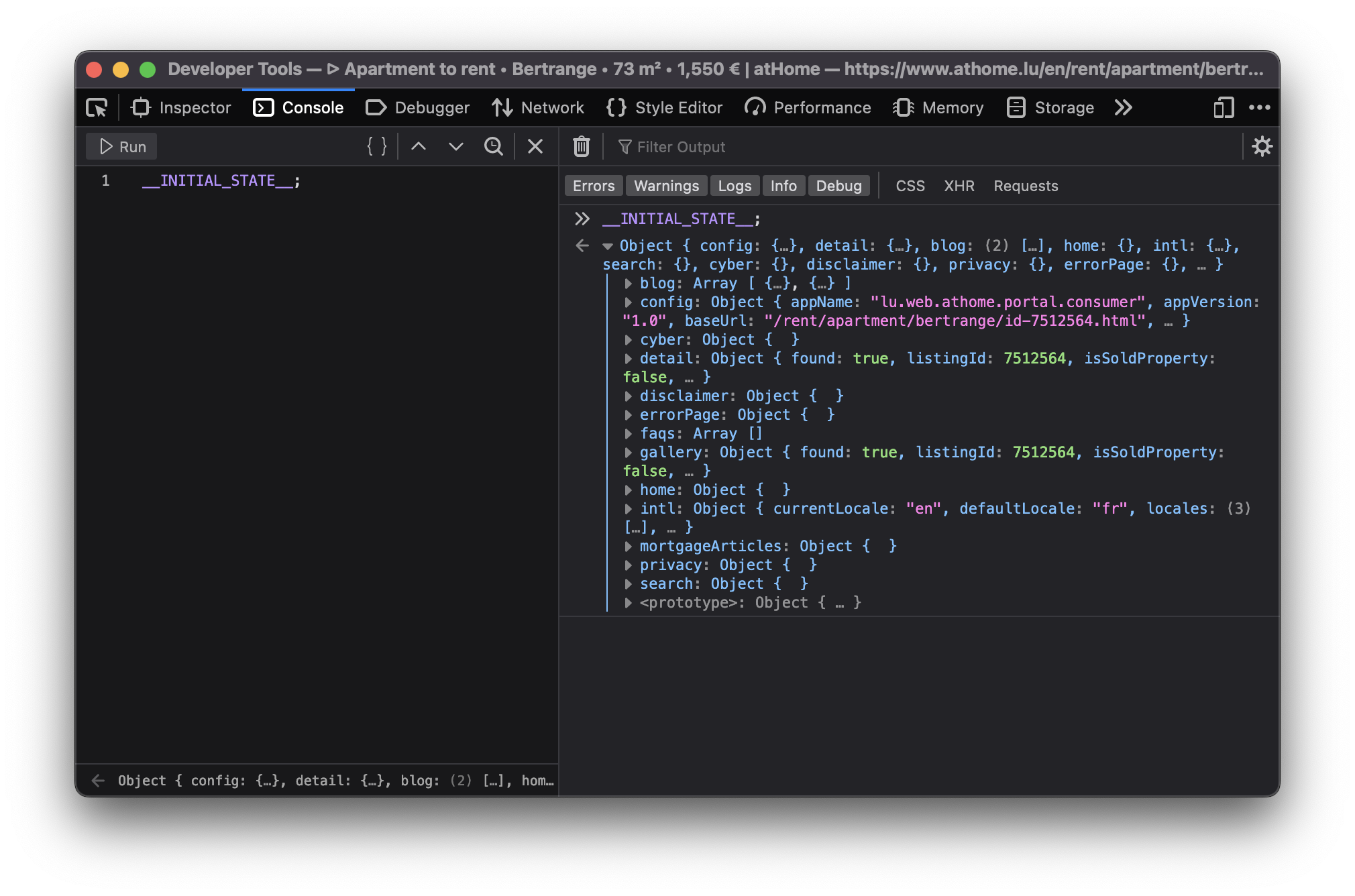
Cool, it seems like a big object to set up the entire page. If we look at
each sub-object of INITIAL_STATE we find detail which
seems to be our lucky card.
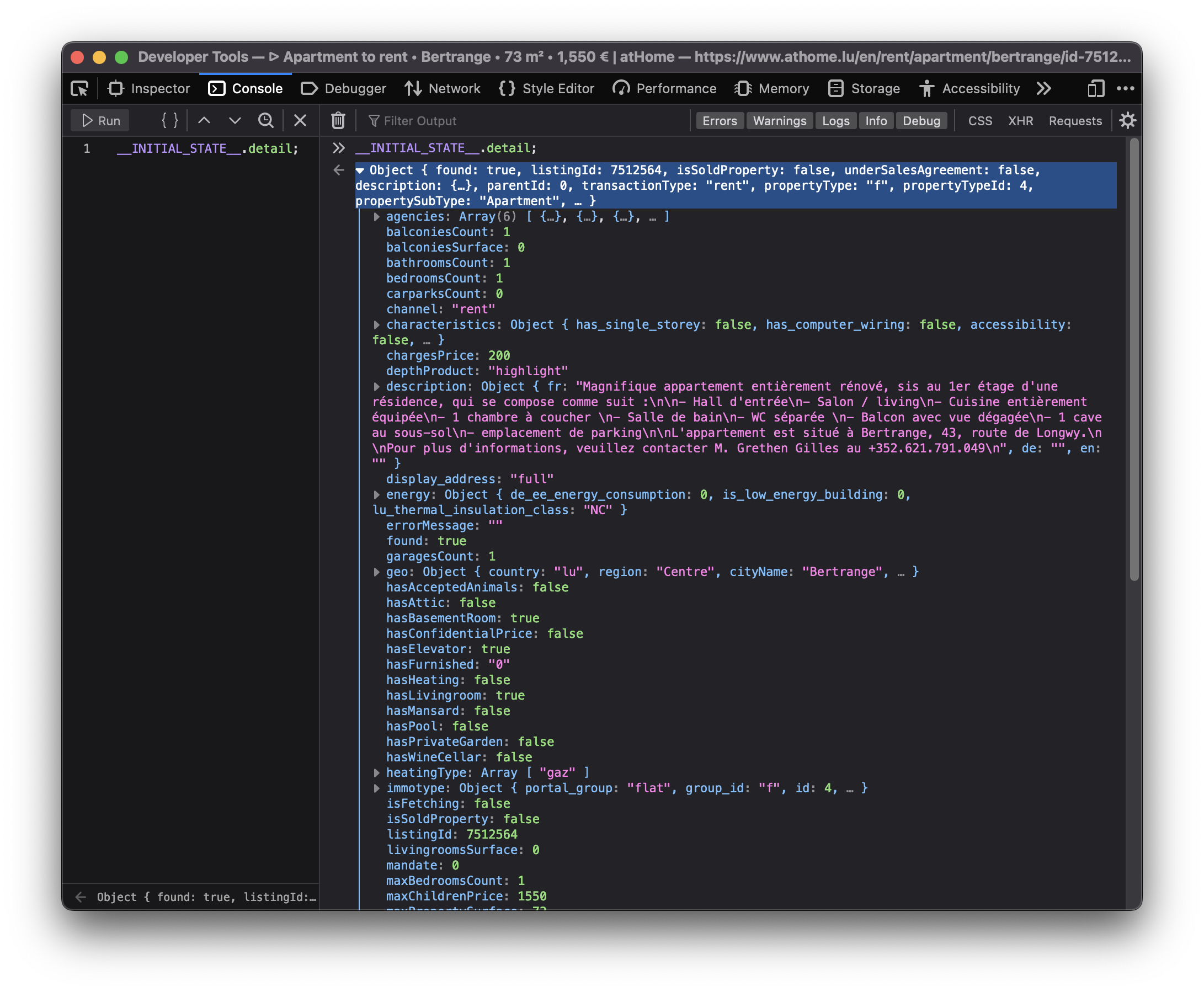
Great! We don’t even have to scrape data from html, we have all the data of the
apartment in this INITIAL_STATE.detail object!
How can I access that variable through code though? I don’t have a great experience with it and I don’t write a lot of JS, but I heard that Puppeteer is the right tool for the job. Let me try something out
const puppeteer = require('puppeteer');
const fs = require('fs').promises;
async function scrape_json_data(browser, link) {
const page = await browser.newPage();
await page.goto(link);
const obj = await page.evaluate(() => {
var { detail } = __INITIAL_STATE__;
return detail;
});
return obj;
}
(async () => {
const browser = await puppeteer.launch({ headless: true });
// File where I'll save all my preferred apartments' links
const data = await fs.readFile(process.env.LINKS_PATH, "utf-8");
// Read line by line
const links = data.split(/\r?\n/);
var objs = [];
for (var i in links) {
let id_pattern = /id-(\d+)/;
// Take id from final part of each link
let id = links[i].match(id_pattern)[1];
console.log("scraping: " + id);
var obj = await scrape_json_data(browser, links[i]);
if (obj.found) {
// Remove all the superfluous data from detail obj
obj = clean_obj(obj);
// Add link to the obj, somehow it's not included in detail obj :/
obj.link = links[i];
objs.push(obj);
} else {
objs.push({ found: false, listingId: parseInt(id) });
}
}
// Save obj data to json file
fs.writeFile(process.env.JSON_OUT, JSON.stringify(objs));
await browser.close()
})();The code above will open a headless instance of chrome, go to each
apartment link that is saved in the file at LINKS_PATH and
spit an array of all the apartment data in a file at JSON_OUT.
We were lucky this time, we didn’t have to go through scraping html, and this would have probably been the most boring part of the entire process. The next steps will be about storing data in a database and visualizing it, but first let’s write a justfile (alternative to a Makefile) that will make our life easier when we need to execute commands.
base := justfile_directory()
json_out := "/tmp/res.json"
links := base + "/homes.txt"
scrape:
LINKS_PATH={{links}} \
JSON_OUT={{json_out}} \
node scraper/main.jsI can now scrape data by just typing
$ just scrapeI want to save all the data to a sqlite database so that I can conveniently check, query and get apartments info whenever I want and however I want.
Let’s move away from js and switch to a compiled language, Go will fit perfectly for this, it’s fast and easy to use.
The binary will parse the entire json file that the scraper created
and load each apartment to the apartment table in sqlite.
I didn’t show it before, but this is my final, cleaned-from-useless-stuff
Apartment struct with some tag annotations to read from json and load into
sqlite by using sqlx.
type Apartment struct {
Found bool `json:"found,omitempty" db:"found,omitempty"`
ListingId uint32 `json:"listingId,omitempty" db:"listingId,omitempty"`
ListingAgencyReference string `json:"listingAgencyReference,omitempty" db:"listingAgencyReference,omitempty"`
IsSoldProperty bool `json:"isSoldProperty,omitempty" db:"isSoldProperty,omitempty"`
Region string `json:"region,omitempty" db:"region,omitempty"`
CityName string `json:"cityName,omitempty" db:"cityName,omitempty"`
Lon float64 `json:"lon,omitempty" db:"lon,omitempty"`
Lat float64 `json:"lat,omitempty" db:"lat,omitempty"`
Price int `json:"price,omitempty" db:"price,omitempty"`
ChargesPrice int `json:"chargesPrice,omitempty" db:"chargesPrice,omitempty"`
Caution float32 `json:"caution,omitempty" db:"caution,omitempty"`
AgencyFee string `json:"agency_fee,omitempty" db:"agency_fee,omitempty"`
PropertySubType string `json:"propertySubType,omitempty" db:"propertySubType,omitempty"`
PublisherId int `json:"publisher_id,omitempty" db:"publisher_id,omitempty"`
PublisherRemoteVisit bool `json:"publisher_remote_visit,omitempty" db:"publisher_remote_visit,omitempty"`
PublisherPhone string `json:"publisher_phone,omitempty" db:"publisher_phone,omitempty"`
PublisherName string `json:"publisher_name,omitempty" db:"publisher_name,omitempty"`
PublisherAthomeId string `json:"publisher_athome_id,omitempty" db:"publisher_athome_id,omitempty"`
PropertySurface float64 `json:"propertySurface,omitempty" db:"propertySurface,omitempty"`
BuildingYear string `json:"buildingYear,omitempty" db:"buildingYear,omitempty"`
FloorNumber string `json:"floorNumber,omitempty" db:"floorNumber,omitempty"`
BathroomsCount int `json:"bathroomsCount,omitempty" db:"bathroomsCount,omitempty"`
BedroomsCount int `json:"bedroomsCount,omitempty" db:"bedroomsCount,omitempty"`
BalconiesCount int `json:"balconiesCount,omitempty" db:"balconiesCount,omitempty"`
CarparkCount int `json:"carparkCount,omitempty" db:"carparkCount,omitempty"`
GaragesCount int `json:"garagesCount,omitempty" db:"garagesCount,omitempty"`
HasLivingRoom bool `json:"hasLivingRoom,omitempty" db:"hasLivingRoom,omitempty"`
HasKitchen bool `json:"hasKitchen,omitempty" db:"hasKitchen,omitempty"`
Availability string `json:"availability,omitempty" db:"availability,omitempty"`
Media *[]string `json:"media,omitempty" db:"media,omitempty"`
Description string `json:"description,omitempty" db:"description,omitempty"`
Link string `json:"link,omitempty" db:"link,omitempty"`
CreatedAt string `json:"createdAt,omitempty" db:"createdAt,omitempty"`
UpdatedAt string `json:"updatedAt,omitempty" db:"updatedAt,omitempty"`
}I might change my mind later down the road on the data that I want to keep
in each Apartment struct, so I might want to make changes to the database structure,
and therefore the queries to insert and update the database too. To make this a bit more
flexible I will use a yaml file to save any database migration and insert/update
queries to the database.
migrations: |
CREATE TABLE IF NOT EXISTS apartment(
found BOOL,
listingId INTEGER PRIMARY KEY,
...
description TEXT,
link TEXT,
createdAt TIMESTAMP DEFAULT CURRENT_TIMESTAMP,
updatedAt TIMESTAMP DEFAULT CURRENT_TIMESTAMP
);
insertQuery: |
INSERT INTO apartment(found,listingId,listingAgencyReference,isSoldProperty,region,cityName,
lon,lat,price,chargesPrice,caution,agency_fee,propertySubType,publisher_id,
publisher_remote_visit,publisher_phone,publisher_name,publisher_athome_id,
propertySurface,buildingYear,floorNumber,bathroomsCount,bedroomsCount,balconiesCount,
garagesCount,carparkCount,hasLivingRoom,hasKitchen,availability,media,description,link)
VALUES (?,?,?,?,?,?,?,?,?,?,?,?,?,?,?,?,?,?,?,?,?,?,?,?,?,?,?,?,?,?,?,?)
updateQuery: |
UPDATE apartment
SET found = ?, listingId = ?, listingAgencyReference = ?, isSoldProperty = ?, region = ?, cityName = ?, lon = ?, lat = ?, price = ?,
chargesPrice = ?, caution = ?, agency_fee = ?, propertySubType = ?, publisher_id = ?, publisher_remote_visit = ?, publisher_phone = ?,
publisher_name = ?, publisher_athome_id = ?, propertySurface = ?, buildingYear = ?, floorNumber = ?, bathroomsCount = ?,
bedroomsCount = ?, balconiesCount = ?, garagesCount = ?, carparkCount = ?, hasLivingRoom = ?, hasKitchen = ?,
availability = ?, media = ?, description = ?, link = ?, updatedAt = CURRENT_TIMESTAMP
WHERE listingId = ?After setting up these basic features and with a little more code
I can compile the program and run it so that it will load the previous
json file into my sqlite apartment table.
Let’s add some more commands to the justfile that we’ve created previously.
db_path := base + "/db.sqlite"
gobuild:
cd {{base}}/loader; go build cmd/main.go
load: gobuild
CONFIG_PATH={{base}}/loader/config.yaml \
JSON_OUT={{json_out}} \
DB_PATH={{db_path}} \
{{base}}/loader/main
fetch: scrape loadLet’s load the data into database
$ just load
> OR
$ just fetch
> which will first scrape data and then load it in the database
> justfiles are cool!Just to get some specs, this runs fast. Take a look
$ cat home.txt | wc
65 66 4469
$ time just load
just load 0.38s user 0.52s system 220% cpu 0.408 totalI now have all the data that I scraped in my nice and super fast database, ready to be queried with the craziest query that comes to my mind, I can think of some.
We’re at a going point at the moment, I have a lot of parameters with which I can query apartments that I like. I can select them by non-decreasing price, by area and if I add some more complex Haversine formulae I could also sort them by distance from the city centre or any other map coordinates.
I won’t stop here though. I have some interesting little vars in
each apartment data: lat, lon. I don’t want to waste geo data!
It’s nice and fun to just look at tabular data, but I think I could
get an easier idea of the location just by plotting stuff on a map.
I want to code something quick with the smallest amount of code, so I’ll go with Python and Jupyter notebook in conjunction with Folium which is a library that generates Leaflet maps.
Let’s setup the map with my point of interest
import folium
lux_coords = [49.611622, 6.131935]
map_ = folium.Map(location = lux_coords, zoom_start = 10)
interesting_coords = [49.630033, 6.168936]
folium.Marker(location=interesting_coords, popup="Point of interest", icon=folium.Icon(color='red')).add_to(map_)
folium.Circle(location=interesting_coords, radius=5000, color='green', opacity=0.5, weight=2).add_to(map_)
folium.Circle(location=interesting_coords, radius=10000, color='yellow', opacity=0.5, weight=2).add_to(map_)
folium.Circle(location=interesting_coords, radius=15000, color='orange', opacity=0.5, weight=2).add_to(map_)
folium.Circle(location=interesting_coords, radius=20000, color='red', opacity=0.5, weight=2).add_to(map_)This will show a map centered on Lux, with a cool red pin on my point of interest and to get a better idea of the distance, I also added some circles with a radius of 5km, 10km, 15km and 20km. This is extremely useful because I can discard immediately by looking at the map of apartments that are too far from my point of interest.
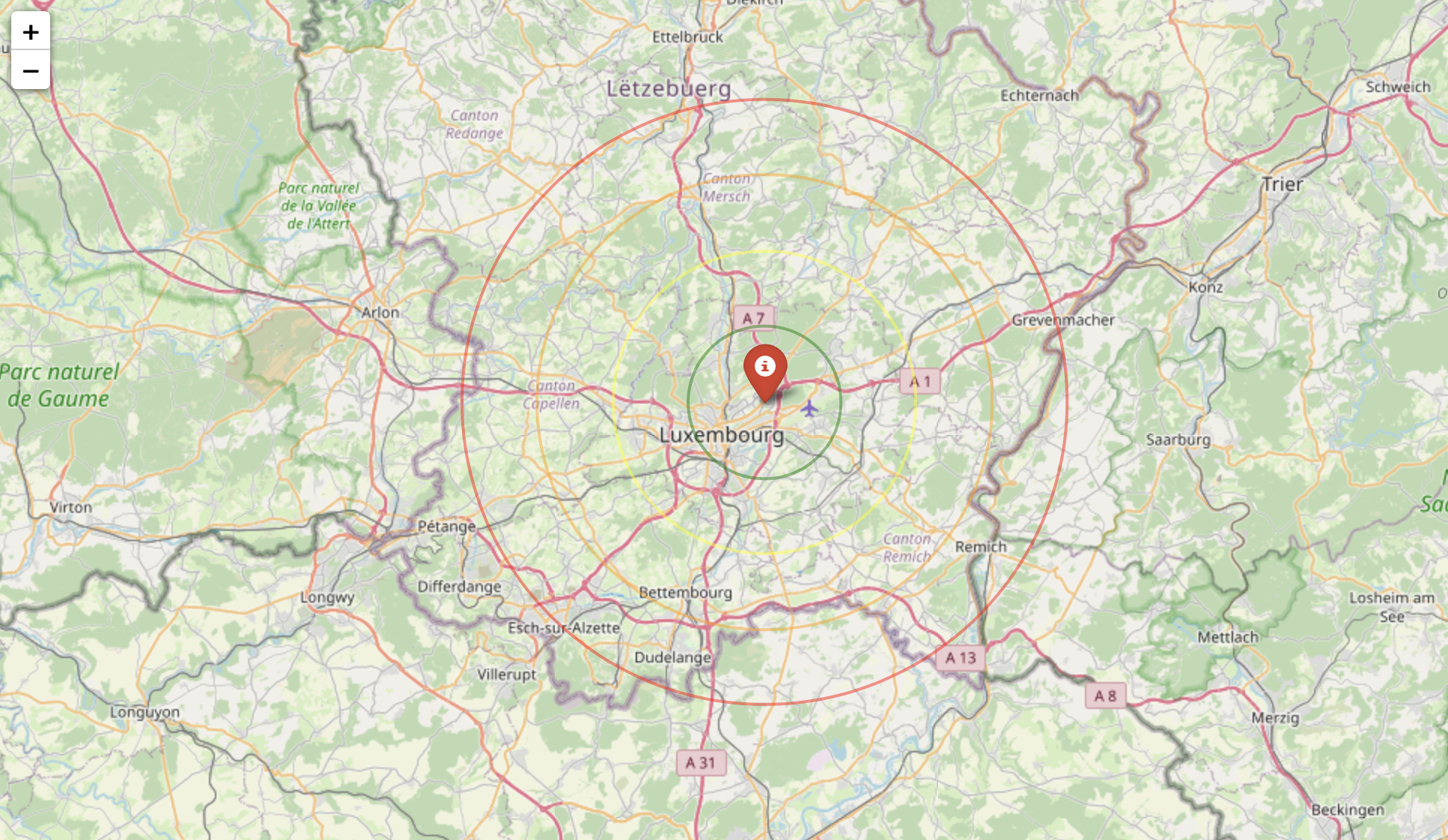
Before going crazy with SQL I need to add my scraped apartments to the map and for the sake of simplicity I will query them all here
import os
import sqlite3
def getApartments(db):
cur = db.cursor()
cur.execute(
"""
SELECT *
FROM apartment
WHERE
found = TRUE
"""
)
return [Apartment(row) for row in cur.fetchall()]
def addApartment(map_, a):
popup = folium.Popup(a._popup_(), max_width=450)
folium.Marker(
location=[a.lat, a.lon],
popup=popup,
# I can use fontawesome to change the pin icon
icon=folium.Icon(color=a._get_color(), icon=a._get_icon(), prefix="fa")
).add_to(map_)
db = sqlite3.connect(os.environ["DB_PATH"])
apartments = getApartments(db)
for a in apartments:
addApartment(map_, a)
map_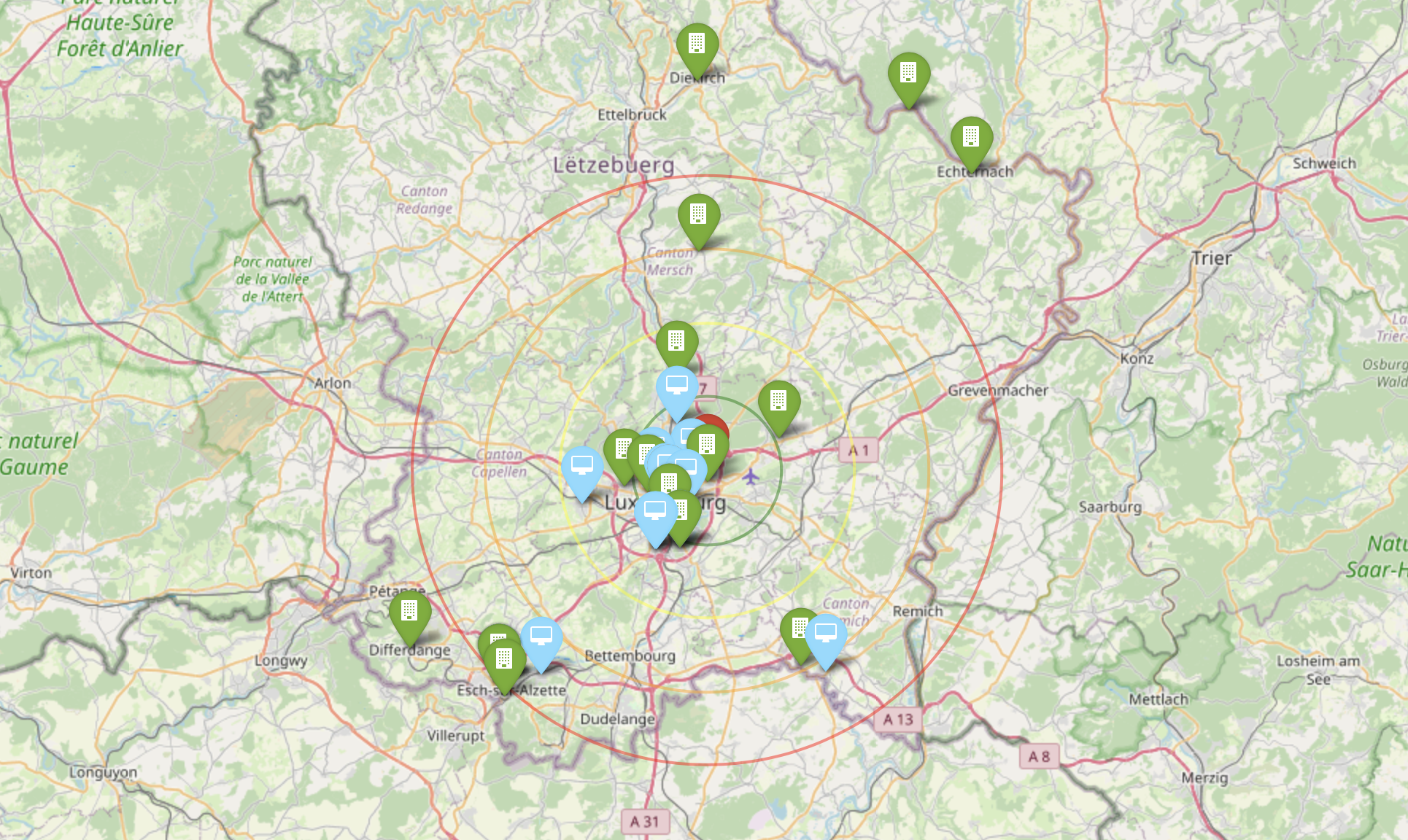
And here we have it! Definitely a much better experience than going back and forth on the website and drawing on a map all the apartments one by one, right?
In the code above you can see that I’ve used a custom popup for each apartment. With Folium we can use HTML to customize the pin’s popup with the most important information I want to see (i.e. monthly total price, initial fee, caution etc.)
def _popup_(self):
return f"""
<h4>Info</h4>
<b>ID: </b>{self.listingId}<br>
<b>Monthly Price: </b>{self.price}<br>
<b>Monthly Charge: </b>{self.chargesPrice}<br>
<b>Caution: </b>{self.caution}<br>
<b>Agency Fee: </b>{self.agencyFee}
<br>
<h4>Total</h4>
<b>Monthly: </b>{self.price + self.chargesPrice}<br>
<b>Initial: </b>{self.caution + self.agencyFee}<br><br>
<a href="{self.link}" target="_blank">Page</a><br>
<a href="{self.galleryLink}" target="_blank">Gallery</a><br>
"""
That’s just what I wanted, I can now see on the map which are the best located apartments in Lux and immediately get to see the info that I’m interested in the most!
Why would I save the data on a database if I don’t use SQL at all? Let’s say that I have a base budget of 1000€ and I want to show only the apartments on which I would have to spend an incremental amount of 200€, I could simply change the SQL query to
SELECT *
FROM apartment
WHERE
found = TRUE AND
listingId IN (
SELECT listingId
FROM apartment
WHERE
found = TRUE AND
price + chargesPrice < 1000 + 200
)Phewww, if you’re still here reading all this you deserve a bonus point.
Imagine I saw a very cool apartment that looks like a very good deal but it’s a bit out of the city, what’s the best way to know how much it is going to take me to get from that apartment to my point of interest with public transportation?
If you paid close attention to the image above you might already know the answer,
Google Maps of course! Google Maps is very cool, you can get directions from
position x to position y by visiting www.google.com/maps/dir/x.lat,x.lon/y.lat,y.lon.
All I need to do is add <a href="{self.mapsDir}" target="_blank">Maps Directions</a>
to the popup dialog I pasted above and I will have a very handy link that
will open Google Maps on a new tab with the time travel from position x to y.
This will save me so much time, you have no idea!
Why don’t we finish this by completing our justfile? In the end I want to type a single command and be shown the map with all the apartments that I saved on my file.
open:
DB_PATH={{db_path}} \
jupyter notebook \
{{base}}/analyzer/apartments.ipynb
show: fetch openThat is so convenient, I can finally only look at pictures of cool apartments, save the link on my file and at the end of the day type
$ just showLife is good now, at least I made the process funnier and more efficient than before!
The only thing that is very slow at the moment is the first js snippet, it takes ~1s to get a single apartment, multiply that for 100 apartments and you will have to wait for a couple of minutes before seeing all the pins on the map. The immediate solution would be to make multiple page requests at a time but I’m not much of an expert with `Promise`s so I think I’ll stick with this solution until I’m not bored again to wait for the tool to scrape each link.
I now need to get back to hunting that apartment, wish me luck!